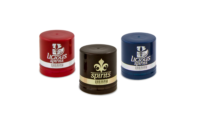Introducing the Next Generation of Composting Packaging Labels: How2Compost

The Sustainable Packaging Coalition has formally launched the new How2Compost label program. How2Compost is an on-package label that informs consumers that packaging is certified compostable, offers directions on appropriate composting, and includes the URL how2compost.info for further information.
The How2Compost label was developed by Sustainable Packaging Coalition in conjunction with the Biodegradable Products Institute (BPI), the leading compostable packaging certification program. By looking for the How2Compost label, consumers can now more easily identify packaging and products that are certified to compost in industrial composting facilities. Every package featuring How2Compost is either certified compostable by BPI, or contains a certified product so consumers can trust that it has gone through required testing and is third-party verified in accordance with standards related to industrial composting facilities.
How2Compost is an extension of the successful How2Recycle program. Like the How2Recycle label, the How2Compost label is a next generation labeling system that brings harmonization and precision to recovery claims on packaging and is designed in accordance with the Federal Trade Commission's guidance over environmental marketing claims. Companies can choose to become a member of How2Compost in order to feature the label on their BPI-certified packaging, to provide additional consumer clarity on the compostability of the various packaging components and related products.
"Compostable products and packaging are continuing to go mainstream, in step with communities and businesses that are diverting food scraps from disposal to composting," says Rhodes Yepsen, Executive Director of BPI. "As such, consumers are becoming more familiar with compostable products at restaurants, sports and music venues, schools, etc., and increasingly on retail shelves. The How2Compost and How2Recycle labels provide a uniform platform for communicating to the public about end of life options, which is particularly critical when the package and product are designed for different recovery streams, one for recycling and the other composting, to ensure they end up in the right collection bin."
The How2Compost program is thrilled to announce its first members, Reynolds Consumer Products and Eco-Products.
Reynolds, makers of Reynolds Wrap® foil, Hefty® trash bags and slider bags, will be using the How2Compost label on selected Hefty disposable tableware products.
"Reynolds has been a proud member of How2Recycle and we are excited to join How2Compost. We hope that clarifying how our products and packaging can be recovered will encourage our consumers to participate in recycling and composting programs in their communities," said Jessica Weninger, Senior Manager of Innovation & Sustainability, Reynolds Consumer Products. "We will be using the How2Compost label on our Hefty microwavable paper plates, and look forward to adding more compostable products in the future."
How2Compost can be used seamlessly next to the How2Recycle label on packaging, for instances where a package can either be recycled or composted, or has some components that are compostable and some that are recyclable.
Eco-Products will begin to use How2Compost in conjunction with How2Recycle on its compostable product secondary packaging.
"When a compostable product is in a recyclable package, this can easily lead to consumer confusion. We know that most consumers want to do the right thing, they just need clear guidance on how to do it. The How2Compost label is an effective way to help people take part in waste diversion," said Sarah Martinez, Sustainability Maven for Eco-Products.
"We have been working diligently over the past two years to bring a thoroughly vetted and consumer-tested How2Compost Label to the marketplace, with the goal of helping composters receive clean streams of material required for appropriate compost manufacturing," explains SPC Senior Manager Anne Bedarf. "As the nationwide focus on food waste and composting increases, the How2Compost Label is poised to provide an important educational tool for the public on not just compostable packaging, but also the value of compost manufacturing infrastructure nationwide."
Looking for a reprint of this article?
From high-res PDFs to custom plaques, order your copy today!








